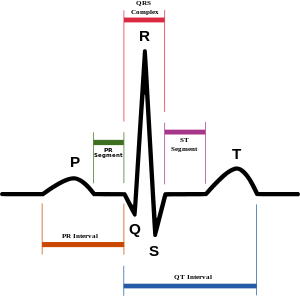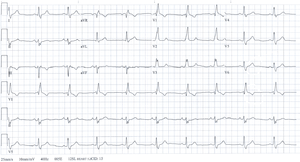Sinus rhythm

A sinus rhythm is any cardiac rhythm where depolarisation of the cardiac muscle begins at the sinus node.[1] It is characterised by the presence of correctly oriented P waves on the electrocardiogram (ECG). Sinus rhythm is necessary, but not sufficient, for normal electrical activity within the heart.
The term normal sinus rhythm (NSR) is sometimes used to denote a specific type of sinus rhythm where all other measurements on the ECG also fall within designated normal limits, giving rise to the characteristic appearance of the ECG when the electrical conduction system of the heart is functioning normally.[2] However, other sinus rhythms can be entirely normal in particular patient groups and clinical contexts, so the term is sometimes considered a misnomer and its use is sometimes discouraged.[3]

Other types of sinus rhythm include sinus tachycardia, sinus bradycardia and sinus arrhythmia. Sinus rhythm may be present together with other cardiac arrhythmias on the same ECG.
ECG characteristics of normal sinus rhythm
By convention, the term "normal sinus rhythm" is taken to imply that not only are the P waves (reflecting activity of the sinus node itself) normal in morphology, but that all other ECG measurements are also normal. Criteria therefore include:[2]
- Normal heart rate (classically 60 to 100 beats per minute for an adult).
- Regular rhythm, with less than 0.16 second variation in the shortest and longest durations between successive P waves.
- The sinus node should pace the heart – therefore, P waves must be round, all the same shape, and present before every QRS complex in a ratio of 1:1.
- Normal P wave axis (+15 to +75 degrees)
- Normal PR interval, QRS complex and QT interval.
- QRS complex positive in leads I, II, aVF and V3-V6, and negative in lead aVR.
References
- ↑ Hampton, John R (2013). The ECG Made Easy (8th ed.). Edinburgh: Churchill Livingstone. p. 4. ISBN 9780702046421.
- 1 2 Conover, Boudreau Conover (2003). Understanding Electrocardiography (8th ed.). St Louis: Mosby. p. 46. ISBN 9780323019057.
- ↑ Geiter, Henry B. (2006). E-Z ECG Rhythm Interpretation (1st ed.). Philadelphia: F.A. Davis. p. 106. ISBN 9780803620353.
External links
- "Normal Sinus Rhythm". Archived from the original on 15 December 2012.